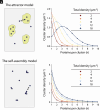Higher-order transient membrane protein structures
- PMID: 39739811
- PMCID: PMC11725870
- DOI: 10.1073/pnas.2421275121
Higher-order transient membrane protein structures
Abstract
This study shows that five membrane proteins-three GPCRs, an ion channel, and an enzyme-form self-clusters under natural expression levels in a cardiac-derived cell line. The cluster size distributions imply that these proteins self-oligomerize reversibly through weak interactions. When the concentration of the proteins is increased through heterologous expression, the cluster size distributions approach a critical distribution at which point a phase transition occurs, yielding larger bulk phase clusters. A thermodynamic model like that explaining micellization of amphiphiles and lipid membrane formation accounts for this behavior. We propose that many membrane proteins exist as oligomers that form through weak interactions, which we call higher-order transient structures (HOTS). The key characteristics of HOTS are transience, molecular specificity, and a monotonically decreasing size distribution that may become critical at high concentrations. Because molecular specificity invokes self-recognition through protein sequence and structure, we propose that HOTS are genetically encoded supramolecular units.
Keywords: GPCR; HOTS; higher-order transient structure; membrane signaling; self-assembly.
Conflict of interest statement
Competing interests statement:The authors declare no competing interest.
Figures









Similar articles
-
Higher-order transient structures and the principle of dynamic connectivity in membrane signaling.Proc Natl Acad Sci U S A. 2025 Jan 7;122(1):e2421280121. doi: 10.1073/pnas.2421280121. Epub 2024 Dec 31. Proc Natl Acad Sci U S A. 2025. PMID: 39739805 Free PMC article.
-
Unnatural amino acids as probes of ligand-receptor interactions and their conformational consequences.Annu Rev Pharmacol Toxicol. 2013;53:211-29. doi: 10.1146/annurev-pharmtox-011112-140343. Annu Rev Pharmacol Toxicol. 2013. PMID: 23294309 Review.
-
Molecular modeling and simulation of membrane lipid-mediated effects on GPCRs.Curr Med Chem. 2013;20(1):22-38. Curr Med Chem. 2013. PMID: 23151000 Review.
-
Emerging Diversity in Lipid-Protein Interactions.Chem Rev. 2019 May 8;119(9):5775-5848. doi: 10.1021/acs.chemrev.8b00451. Epub 2019 Feb 13. Chem Rev. 2019. PMID: 30758191 Free PMC article. Review.
-
Supramolecular Assembly of Peptide Amphiphiles.Acc Chem Res. 2017 Oct 17;50(10):2440-2448. doi: 10.1021/acs.accounts.7b00297. Epub 2017 Sep 6. Acc Chem Res. 2017. PMID: 28876055 Free PMC article.
Cited by
-
Lipidic folding pathway of α-Synuclein via a toxic oligomer.Nat Commun. 2025 Jan 17;16(1):760. doi: 10.1038/s41467-025-55849-3. Nat Commun. 2025. PMID: 39824800 Free PMC article.
-
Detergent-free isolation and characterization of amyloid precursor protein C99 in E. coli native lipid-nanodiscs using non-ionic polymer.Protein Sci. 2025 Sep;34(9):e70276. doi: 10.1002/pro.70276. Protein Sci. 2025. PMID: 40828514 Free PMC article.
-
Higher-order transient structures and the principle of dynamic connectivity in membrane signaling.Proc Natl Acad Sci U S A. 2025 Jan 7;122(1):e2421280121. doi: 10.1073/pnas.2421280121. Epub 2024 Dec 31. Proc Natl Acad Sci U S A. 2025. PMID: 39739805 Free PMC article.
-
Molecular contacts in self-assembling clusters of membrane proteins.Proc Natl Acad Sci U S A. 2025 Jul;122(26):e2507112122. doi: 10.1073/pnas.2507112122. Epub 2025 Jun 23. Proc Natl Acad Sci U S A. 2025. PMID: 40549920 Free PMC article.
References
MeSH terms
Substances
Grants and funding
LinkOut - more resources
Full Text Sources
Miscellaneous

